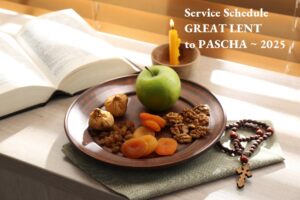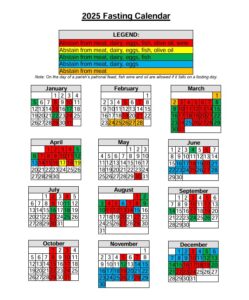Fr. Jon Braun describes the beauty of an Orthodox parish that enjoys the strengths that come to a diverse congregation composed of life-long Orthodox as well as convert and re-vert Orthodox Christians. Our own parish of Holy Trinity – composed primarily, but not exclusively, of converts to the Orthodox faith – seeks to live the blessing of such a “house blend.”
“House Blend” by Fr. Jon Braun
When it comes to good coffee, caffeine lovers may be familiar with the “House Blend”—each restaurant’s or coffee roaster’s recipe for brewing the “perfect cup” that appeals to the greatest number of people. Not some exotic specialty roast like Mocha Java, Sumatra, or Jamaican, the house blend is designed to be a happy meeting ground, something that will accommodate the widest variety of tastes and appetites.
Mind you, not everyone who loves coffee likes the house blend. That’s all right; it is not necessary, or even desirable, that they should. But on the other hand, there is surely nothing wrong with the way it tastes, and for those who understand why and how the house blend is best used, it makes very good sense.
In terms of the Orthodox Church and its establishment here in North America, I believe there is a growing need for what might be called the “Orthodox House Blend.” I am talking about a “house blend” in churches, if you will—a mixture that accommodates the many and varied backgrounds of people coming into Orthodox parishes.
It happens to be my good fortune to be the pastor of a start-from-scratch “house blend” parish, and it’s quite an experience. After a year and a half, we’re a brew of almost everything! For openers, a little more than half our people are converts to the Orthodox Faith. But even the portion of our people who have an Orthodox background is mixed. A slender majority have been active in the Orthodox Church all their lives. Still others left the Orthodox Church and went to Protestant churches for a period of time, but they’ve come back. And there are those who left the Orthodox Church, for various reasons and at various ages, and went nowhere at all for many years. Now they’ve come back to the Church because they really like the “house blend.” They feel at home because of the blend of people.
As I see it, Orthodox parishes in North America today come in three basic models, or blends.
First, for most of the two hundred years since Orthodoxy came to America, the great majority of Orthodox churches have had a defined ethnic identity. They looked back to a mother church and a mother country. So we find Greek Orthodox churches, Romanian Orthodox churches, Russian Orthodox churches, Syrian Orthodox churches, and so on. True, there are often a few people from other backgrounds in these churches, but for the most part they are spouses of ethnic members—with a few occasional converts sprinkled in. Ethnic churches aren’t the house blend. They are an important special blend.
Secondly, in recent years there have emerged parishes that are comprised almost entirely of converts to the Orthodox Faith. These parishes aren’t house blend either. They are another important specialty. They aren’t for everyone, but they do have an extremely significant role in the full scope of Orthodox life in North America.
But now, thirdly, there are a growing number of Orthodox parishes emerging on North American soil which began as ethnic parishes, or at least sprouted from an ethnic base, but which have quite intentionally sought to add significant percentages of converts to the makeup of the parish. The number of this blend of parishes is growing rapidly. This last model is what I would call the “house blend.” Conceivably some in ethnic or convert parishes may feel these don’t “taste” very good. “Too strong or too weak,” some may say. And we who are in these house blend parishes don’t mind their feeling that way, but we ourselves really do like the taste.
GETTING DOWN TO TERMS
This blend illustration may be better understood if we get down to cases with three terms: ethnic, cradle, and convert.
Ethnic churches are simply a common strand of the fabric of the American experience. And they are by no means unique to Orthodoxy. The Episcopal Church, for example, was and is an ethnic church; its ethnicity just happens to be English.
But the ethnic experience goes far beyond the Episcopalians. There are Irish Catholics,
Italian Catholics, and Polish Catholics. And among the Protestants, there are German Lutherans, Swedish Lutherans, and Danish Lutherans, to name a few. And there are Scottish Presbyterians. My dad grew up in a Low German-speaking Mennonite church. My wife grew up in a Swedish Mission Covenant Church. And I have only begun to name the churches that were or still are, in some measure, ethnic.
One memorable “ethnic experience” I treasure goes back to my basketball-playing days for the San Jose Covenant Church, a church Swedish in background. I was the center, so the team roster read like this: Peterson, Pederson, Braun, Swanson, Johnson. I’d say that suggested an ethnic background!
It seems to me North Americans don’t look disparagingly at churches with a Western European ethnic background. But woe to those from Eastern Europe or the Middle East! They’re foreigners. They are judged so severely for what goes completely unnoticed elsewhere.
Ethnic churches are not de facto bad churches, and their ethnicity should never be a criterion for judging them. Frankly, I’m tired of people casting the term “ethnic” about with respect to Orthodox churches, as if “ethnic” were some nasty, but easily curable (all you have to do is become like us) disease. There are even ugly aspersions flung about with respect to whether “ethnics” are truly Christians. That is nothing more than American fundamentalist nonsense—as if you’ve got to speak English and be at least a fourth-generation Heinz 57 variety to be a genuine Christian in America. (American fundamentalism itself is a branch of American ethnic religion!)
Of course many problems must be addressed in ethnic churches as they take root in a new homeland. That takes time. And if they are trying to use the Kingdom of God to preserve and perpetuate an ethnic heritage, that is totally inappropriate. The Kingdom of God has its own ethnic identity, namely heaven! But just because a church’s services are in Arabic or Greek or Slavonic doesn’t mean they are perpetuating a heritage at the expense of the Faith. And for goodness’ sake, are there not literally thousands of American “ethnic” churches that are confessedly committed to preserving and perpetuating the “American way of life” and/or “the American dream”?
“Cradle” is the second term we need to work with. Of course there are cradle Orthodox. Strange, isn’t it? I’ve never heard the word “cradle” used of anyone but Orthodox, and so often it is used as if it were a malady.
Really, all we mean by “cradle Orthodox” is people who have been Orthodox since they were in the cradle. And what’s wrong with that? Aren’t there cradle Baptists? Cradle Pentecostals? Cradle evangelicals? Cradle charismatics? Even those of us who are converts to Orthodoxy are often prone to use the expression “cradle Orthodox” to mean, “not as committed as we are.” Frankly, that attitude reveals a sinister pride which should have no place among a people whose daily prayer is. “Lord Jesus Christ, Son of God, have mercy on me, a sinner.”
In fact, it may be quite a compliment for people to be called “cradle Orthodox,” At least it testifies to the fact that they’ve stuck to the Faith of their Fathers—quite a feat these days, when people change (or drop) their faith, their denominations, and their religions, with the ease and aplomb with which they switch automobiles.
Still, in all fairness, it must be admitted there are cradle Orthodox who have virtually no clue about their faith, They’ve just bumped along over the years going along with the program, as it were, but never making a true commitment to Christ or the Church. Perhaps the tie was ethnic heritage. Perhaps it was family. Maybe it was just a felt need for church. Whatever it was, it was never enough to press them into digging into the heart of their Faith.
This problem is not unique to Orthodox Christians. All churches, should they survive twenty years, are going to encounter that troublesome predicament. That doesn’t excuse lack of commitment, but it does make it understandable.
Finally, we need to look at the word “convert.” Being a convert myself. I must say I had a hard time with the word. After all, I was a Christian before! But I’ve come to deal with the reality that becoming Orthodox is a type of conversion. For some of us, it was quite a radical departure from where we once found ourselves to enter into a Church that is historic, liturgical, and sacramental.
And sometimes the cradle Orthodox don’t realize how difficult this conversion can be. Some cannot grasp the inner wrenching we went through to make the change. There are even some who are at a loss to understand why we find Orthodoxy such a treasure. Indeed, converts are sometimes looked down on as ignorant newcomers to be held in suspicion.
Where an atmosphere of suspicion and belittling tends to peak is in those environments where cradle and convert are effectively separated from one another. And, conversely, those issues fade when they are together. At my parish, the proportion is 55% convert and 45% cradle. (I’m probably the only one in the parish aware of those figures.) But we don’t think of each other as cradle or convert. We think of each other as brothers and sisters in Christ: we see each other as Orthodox Christians, and members of the same Body. I must admit that when I’m outside my own parish and meet some cradle Orthodox, I occasionally still feel the suspicion so strongly, I’m sure they feel the same coming from me. But in my “house blend” parish, we don’t have that problem.
Further, without for a moment suggesting that the all-cradle or all-convert parishes aren’t good models, we would insist that our model, the “house blend,” is a wonderful model. It has some distinct advantages, and in the long haul it will appeal to the greatest number of people— not because it’s inherently the best, but because of people’s tastes. Take a look at just four appealing attributes of the house blend.
ADVANTAGES OF THE HOUSE BLEND
1) Balanced Christian Living.
Balance is a quality that is often hard to come by in Christian living. In the house blend church, every cradle believer and every convert has some degree of influence on the whole—perhaps far more than when everyone has the same background. Cradle Orthodox are challenged by the zeal of the converts, but the converts are balanced by the experience and history of the cradles.
I see this dramatically experienced during the Lenten fast. The cradles have been involved in the fast from their youth. Some have kept it well; some hardly at all. But they have an experience of it, and they know what it should be. It’s in their memory banks (and their cookbooks!). We converts, on the other hand, tend to start the long-distance race of Lent sprinting. That’s not the way to finish such a grueling race! I see the interacting balance working, and all are encouraged. More run the race to the end.
But balance is a two-way Street, and cradle Orthodox are balanced by converts too. Most people, for example, who grow up in an Orthodox church simply never think of sharing their faith with anyone else—even of inviting someone to attend their church with them. Most converts, however, are very comfortable with that and have done so much of their lives. With a mixture of cradle and converts, all are encouraged.
2) Modeling.
There is great value in “doing things as second nature,” as it were. Think of how much all of us have learned from our parents, our churches and our schools—ways we speak, things we do, how we drive our cars or decorate our Christmas trees, and how we meet and greet one another. In the “blend” church, so much is learned by converts, who quickly come to imitate those who grew up in the Faith.
Take the matter of “church etiquette” —things like how we enter the church, how we relate to icons and respond in the Liturgy, how we bake the Holy Bread, how we talk to a priest or greet a bishop—just to name a few items. As converts come to do these things the way they are modeled for them by the cradles, the latter often come to a new appreciation of why they themselves do these things. A reciprocity occurs here, and it’s healthy—to say nothing of saving time (and sometimes a good deal of embarrassment!).
3) Contagious Commitment.
Converts, just by their presence, tend to challenge all the people of a parish or mission to greater commitment to Christ and His Church. The fact of being a convert often implies a strong commitment to Christ. All, cradle or convert, who are committed to Christ, are a challenge
to others to “commend ourselves and each other and all our life unto Christ our God.”
But there’s also the “little” matters commitment that are affected in the blend. Getting to church on time, tithing (or least very significant giving), participation in the services, attendance at Vesper Matins, feast days—all are affected. A leavening occurs in the whole lump. Some cradle Orthodox may have developed some careless habits in these matters. The blend encourages all,
4.) Integration.
One final advantage of the blend model which is not to be overlooked is the ease with which we converts can be melded into the whole of the Orthodox Church—in our deaneries, our regions, our archdioceses, and the Orthodox world at large. The integration into all of these becomes normal and natural rather than traumatic.
The “suspicion factor” of converts is greatly reduced. The shock of the “ethnicity factor” is also diminished. Those gulfs have already been crossed, or at least addressed. And the “who-taught-the-converts factor” doesn’t even get consideration. The mix in the parish carries over into the larger Church to such an extent that acceptance of both cradle and convert is much more easily accomplished by all. Genuine Christian tolerance of one another and our respective backgrounds finds good soil for growth, because the cultivation has already begun.
These are not the only advantages, but they stand out as examples of how the house blend model can appeal to the many. Of course it is not the only model. It would be inaccurate and inappropriate even to say it is the best. No model is the best. All have their place, and all are needed. But the house blend must not be overlooked, and we will see more and more of these parishes as the distance in time and culture from homelands grows, converts increase in numbers, and Orthodox life grows stronger on this continent.
The Very Rev. Jon Braun is pastor of Saint Anthony Orthodox Church in San Diego. California.



